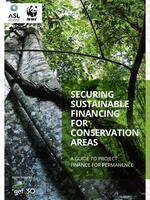Almost every state in the United States—and almost every country in the world—has a national park or wildlife refuge. And while they are beautiful places to explore and enjoy, they are also our lifeline. Trees help keep our air and water clean, rivers help generate energy, and vegetation feeds much of the world’s wildlife.
Though often referred to as protected areas, most of these vital places are only protected on paper. Limited funding, government policies, and skills to ensure they are properly managed make it nearly impossible to keep the threats to protected areas—such as illegal logging and mining and wildlife poaching—at bay. If we let them become degraded, downsized, or erased altogether, we break our lifeline.
To address this issue, WWF works with government leaders, public and private sector donors, NGOs, and others to securing funding that is used to cover expenses related to properly managing conservation areas, which includes protected areas, community lands and other types of land designated for sustainable use or no development. Funds are allocated to buy boats that are used to patrol coastlines to look for people fishing illegally or to buy drones that are used to spot wildfires. Funds also are used to convene workshops to teach people about ecotourism opportunities in or near protected areas. And so much more.
Although most of the funding is used for better management of conservation areas, some is used to create new conservation areas or expand existing ones, as there simply are not enough of them in the world to combat climate change and ensure that people and wildlife live healthy, long lives. Mangroves, for example, serve as a barrier between people and large waves during coastal storms. And rivers supply us with fish—one of the most popular sources of protein around the world.
To be eligible for the funds, the national government of a given country must commit to putting in place the policies and staffing needed to make sure the conservation areas program runs smoothly. Also, a source of in-country funding must be identified to fully finance the areas after the initial funding from donors runs out.









 Meg Symington
Managing Director, Amazon
Meg Symington
Managing Director, Amazon
 Christopher Holtz
Vice President, Earth for Life
Christopher Holtz
Vice President, Earth for Life
 Harry Jonas
Senior Director, Conservation Areas
Harry Jonas
Senior Director, Conservation Areas
 Katie Zdilla
Director, Earth for Life
Katie Zdilla
Director, Earth for Life
 Scott Lin
Senior Program Officer, Area-Based Conservation Finance
Scott Lin
Senior Program Officer, Area-Based Conservation Finance
 Chris Weaver
WWF Senior Advisor, Inclusive Conservation, Enduring Earth
Chris Weaver
WWF Senior Advisor, Inclusive Conservation, Enduring Earth
 Johana Deza
Senior Program Officer, Conservation Areas
Johana Deza
Senior Program Officer, Conservation Areas
 Trisha Patel
Program Officer, Earth for Life
Trisha Patel
Program Officer, Earth for Life
 David Flickinger
Managing Counsel, Senior Director
David Flickinger
Managing Counsel, Senior Director
 Carolina Ortiz
Senior Program Officer, Area-Based Conservation Planning and Finance
Carolina Ortiz
Senior Program Officer, Area-Based Conservation Planning and Finance
 Jon Tua
Senior Director, Strategic Planning and Finance, Earth for Life
Jon Tua
Senior Director, Strategic Planning and Finance, Earth for Life